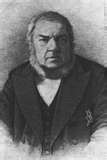Hahn, Carl Wilhelm (1786-1835)

BIOGRAPHICAL NOTE
Dr. Carl Wilhelm Hahn (lat. Carolus Guilielmus Hahn) (* December 16, 1786 - † November 7, 1835) was a German zoologist and author of the first German monograph on spiders. C. W. Hahn was an all-round natural scientist - not at all unusual for his time. Surprisingly he seems to have been almost forgotten.
Carl Wilhelm Christian Hahn was born in Weingartsgreuth, Upper Franconia as the first son of Johann Michael Hahn (1734–1824), who was court and palace gardener on the estate of Baron von Seckendorff, later palace gardener for Count Friedrich von Pückler. C. W. Hahn obeyed the general call to arms as early as 1813. He served as a quarter master and in 1816 received his honourable discharge. Afterwards he lived with his parents in Fürth and, according to Hahn, made up his mind to devote his life to his predilection for natural history, an interest he had had since early childhood and which intensified during his studies in Erlangen. He commenced work on his first ornithological work "Birds from Asia, Africa, America and New Holland". When his "often promised and well earned position"failed to materialize, Hahn undertook what was for that time, in his field, a very unusual step and went freelance. From then on he called himself a natural historian and occasionally also a scholar. On 24 February 1820, having in the meantime qualified as a Dr. Phil. at the University of Erlangen, he married Victoria Francisca Kaltdorff, née Schaefer. His wife, the widow of a doctor of medicine, was about five years older than he, and had three children by her previous marriage. She was at this time without means, but was expecting quite large inheritance from her maternal uncle before long. Their own child Anna Friedericke was born at the end of 1820 or 1821.
It can be assumed, that Hahn was in close contact with the universally known natural scientist Jakob Sturm and probably with his two sons. He named a spider species after Jakob: Araneus Sturmii, now Atea sturmi (Hahn, 1831. His relationship with Johann Georg Wagler must have been similarly close. He also named a spider species after him: Lÿcosa Waglerii, now Pardosa wagleri (Hahn, 1822)Nothing reliable is known about other contacts within the remarkably productive Nuremberg zoologist scene. Nor is there any proof, that Hahn knew Franz von Paula (von) Schrank personally, a highly regarded natural scientist, to whom he dedicated the "Monograph on Spiders". The scientific value of Hahn's lifework in natural history varies. His ornithological work, for example, never had any discernible influence on this field. On the other hand Hahn's work on the true bugs (Heteroptera) is just as important as his works on spiders (Araneae). One species of bug even carries his name: Lopus hahni Stål, 1860. He was also given this honour in the field of arachnology: Carl Ludwig Koch, who continued "Die Arachniden" after Hahn's death, called a genus after him in 1841 (Hahnia), on which later the name of the whole family was based - Hahniidae Bertkau, 1878.
According to L. Gebhardt, Hahn died in Nuremberg on 7 November 1835, "of a lung complaint in the prime of life".
PUBLICATIONS
- Hahn, C.W. 1832. Die Wanzenartigen Insecten. Getreu nach der Natur abgebildet und beschrieben 1 (3): 80-117. Nürnberg. [(30).xi.1832.]
REFERENCE
- Capinera, J.L. (Ed.) 2004. Enclyclopedia of Entomology 2: 1044.
- Sherborn, C. D. 1914. On the contents of the parts and dates of publication of C. W. Hahn and G. A. W. Herrich-Schaeffer, 'Die Wanzigartigen Insecten,' 1831-1853. Annals and Magazine of Natural History (8)13:365.